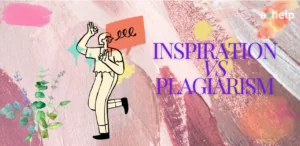Plagiarism avoidance techniques are familiar to most students, with quoting often recognized as a primary method. However, simply being aware that quoting can prevent plagiarism is not enough to actually avoid it. You need to understand the principles and master the rules of proper quoting techniques to write a plagiarism-free research paper.

✅ AI Essay Writer ✅ AI Detector ✅ Plagchecker ✅ Paraphraser
✅ Summarizer ✅ Citation Generator
What is Quoting?
Quoting is a vital aspect of writing that involves the inclusion of someone else’s exact words into your text. This process requires precise compliance with format, including the use of quotation marks and appropriate citations to avoid plagiarism. Below we discuss in more detail when and how to use quotes effectively in your writing.

Quoting serves one primary purpose: it supports the credibility of the argument presented in your research paper. It’s also required to respect the intellectual property rights of the original author whose ideas, theories, or discoveries you used to write your paper or thesis.
As a plagiarism preventive measure, quoting is a powerful skill. However, it’s important to understand that it is not a “one size fits all” solution and can’t be applied as a universal approach. Let’s explore the appropriate contexts for using citations.
| 💪 To Reinforce a Point | 🧐 To Preserve the Authority of the Expert |
| A quotation usually is a strong evidence for the argument or point you are making. If the original expression by the author is clear and impactful, quoting can lend authority to your discussion. | When an expert’s specific words carry weight due to their authority or established reputation, using their exact words can enhance the persuasiveness of your argument. |
| ✍️ When Language Matters | 🔎 To Provide a Precise Definition |
| Certain phrases or terminology may be unique or coined specifically by an author. Altering them would diminish their meaning. In such cases, it is crucial to quote the words as they are. | When discussing specific concepts, especially in technical or specialized fields, direct quotations ensure that the definition remains accurate and unchanged. |
As you see, quoting is a powerful tool in academic writing that, when used appropriately, can significantly strengthen your arguments by invoking the credibility and authority of the source. However, it requires careful consideration of when it is necessary and how it is integrated into your content to maintain the originality and integrity of your work.
Try our Free Plagchecker
How To Avoid Plagiarism With Direct Quotations?
Before looking at how using direct quotations can assist in avoiding plagiarism, it’s important first to distinguish the various forms of plagiarism and explore how quotes can be effectively utilized in each scenario.

This unethical practice can take different forms, each affecting the integrity of academic and professional work in its specific way:
Direct Plagiarism: occurs when text is copied word-for-word from a source without quotation marks and without attribution.
| ⚠️ Quoting as a Solution: Direct plagiarism is straightforwardly prevented through proper quoting and citation. By using quotation marks and crediting the source, the writer acknowledges the original authorship. |
2. Self-Plagiarism: reusing one’s own published work in new contexts without acknowledging the original context or publication is considered self-plagiarism.
| ⚠️ Quoting as a Solution: Since the issue here is the reuse of one’s own words, proper citation is required even if the material is the author’s previously published work. Quoting can be used if the text is being presented as it appeared originally. |
3. Mosaic Plagiarism (AKA Patchwriting): involves piecing together ideas, phrases, and words from multiple sources to create a new text, often without proper citations.
| ⚠️ Quoting as a Solution: To avoid mosaic plagiarism, each piece borrowed from another text must be accurately quoted and cited. This acknowledges the original sources and differentiates the author’s own ideas from those borrowed. |

4. Accidental Plagiarism: is often a result of negligence, lack of knowledge, or misunderstanding about citation and paraphrasing. Accidental plagiarism happens when authors inadvertently paraphrase someone’s words too closely or forget to cite sources.
| ⚠️ Quoting as a Solution: Educating oneself on the updated documentation of sources and employing direct quotes when exact wording is necessary can prevent this form of plagiarism. |
5. Source-Based Plagiarism: happens when the source material is incorrectly cited, or fake citations are created.
| ⚠️ Quoting as a Solution: Using direct quotations with precise and verifiable citations ensures the original source is accurately acknowledged. |
Key Rules of Quoting
The correct use of direct quotations is a fundamental aspect of academic writing that prevents the serious issue of plagiarism and supports your arguments. Here are detailed guidelines on how to effectively incorporate direct quotations into your research papers:
✅ Use Quotation Marks: enclose the exact words of the author within quotation marks. This indicates that the text has been taken verbatim from another source, differentiating it from your own narrative.
✅ Provide an Introduction: before presenting a quotation, introduce it with your own words. This introduction should set the context and prepare the reader for what is coming. This could be as simple as a lead-in phrase that mentions the author or source, or a full sentence that sets up the relevance of the quote.
✅ Add Citations: immediately after the quotation, include an in-text citation that specifies the source, and ensure this source is fully detailed in the reference list at the end of the document. The citation must include all necessary information such as the author, page number, and publication date.
Step by Step Quoting
Follow the structured steps described below to integrate direct quotations into your academic writing correctly. This will enrich your paper, making it look more credible and guarantee that you respect intellectual property laws and avoid the pitfalls of plagiarism.
| How to Quote Properly | |
|---|---|
| Identify & Copy | Locate a segment of text from a source (e.g., book, journal article, website) that you wish to quote. Make sure it supports your argument or adds value to your discussion. |
| Quotation Marks | Place the chosen text within quotation marks. This is important to indicate that these specific words are not your own. |
| In-Text Citation | Append an in-text citation at the end of the quote outside the closing quotation marks. The citation format will depend on the citation style you are using (APA, MLA, Chicago, etc.). |
| Write Context: | Introduce the quote in a way that naturally integrates it into your writing. The introduction can include a brief mention of the author’s name, their qualifications, and why their opinion or statement is relevant to your topic. |
| Add to Paper | Incorporate the quote into your essay or paper. Make sure it flows logically with your own words and effectively supports the points you are making. |
| Full Citation | Include a full citation in the reference list at the end of your paper. This citation should provide all the details necessary for a reader to locate the original source. |
Look at the example below to see how a well-formatted quotation would look in your research paper. Stick to a similar style to leave plagiarism no chance!
|
Dr. Jane Goodall notes, “The compulsive behavior witnessed in social media users is akin to addiction, with significant psychological repercussions,” (Goodall, 2021, p. 118). In this example:
|
FAQ
Follow us on Reddit for more insights and updates.





Comments (0)
Welcome to A*Help comments!
We’re all about debate and discussion at A*Help.
We value the diverse opinions of users, so you may find points of view that you don’t agree with. And that’s cool. However, there are certain things we’re not OK with: attempts to manipulate our data in any way, for example, or the posting of discriminative, offensive, hateful, or disparaging material.